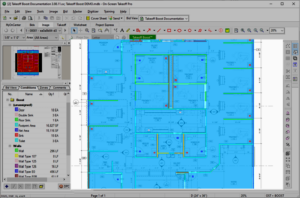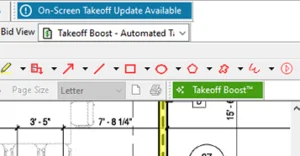In the wake of COVID-19, all efficiencies that can be gained—from the takeoff process through the project build-out—begins with a high-quality bid. Your bid should be built on the accuracy and timeliness of your company’s takeoff and estimation process.
As trades become more specialized, complex, and precise, construction pros must work hard to reduce waste and increase profits. Just as your construction business may need to invest in equipment like bulldozers and backhoes, you can look to digital tools and software to improve your bidding efforts.
For example, the walls and ceilings trade once only involved covering studs and rafters. Today’s trade installs firewalls, sound walls, smoke walls, and more sophisticated structures like positive-pressure walls to seal and keep out contaminants from other sources.
No doubt, your drive for accuracy begins with the digital takeoff interpretation of structural/engineering drawings and designs to assure that all requirements are addressed upfront. This is the best way to avoid unnecessary problems down the road, such as failed inspections, rework, and project penalties.
Estimators Still Lean on Spreadsheets
Before digital technologies, the tools used for takeoff and estimating consisted of the rolling linear scale, colored pencils, highlighters, ledger pads, and a calculator. As personal computers became common in business, estimators replaced their calculators and ledgers with electronic spreadsheets and complex formulas.
Many estimators still use these tools today to manually perform material takeoffs and to generate educated cost “guesstimates” that slowly make their way into formal bids.
In fact, nearly 65% of construction pros surveyed in the 2019 JBKnowledge ConTech report said they rely on spreadsheets as part of their workflow process. On the plus side, the report found that spreadsheet dependency dropped 1% over the previous year.
Of those workflows using dedicated software, the report found 54.6% were using software for estimating and 37% reported using digital tools for takeoff. While nearly 90% of those taking the survey use dedicated tools for Accounting/ERP and another 58% for Project Management, there still seems to be resistance to using digital tools for critical workflows like takeoff and estimating.
Save Time and Money with Digital Tools
Many estimators still spend hours carefully combing through numerous printed plans to calculate product counts, such as the number of drywall screws, the amount of tape and mud, and the amount of estimated waste.
It takes significant time and skill to determine the material values due to unique conditions and odd shapes where it’s challenging to measure correct values. It is a huge time-saver when you can count similar objects automatically and take off areas that are the same height and depth throughout a plan—versus counting similar items by hand.
More importantly, the process of change orders and requests for alternates can slow any estimator down. When done manually, an estimator must sift through marked-up plans and prior estimates to work up a change or develop an alternate and incorporate it into the overall project budget and bid. Even small changes create a time burden that adds to the cost of bidding on projects—and takes away from the profit margin.
With digital tools, you can take the guesswork out of takeoff and estimating to eliminate inefficiencies and redundancies. Contractors save time and money because they can more easily see the scope of work and the impact of design changes or change orders. With faster, more accurate estimates, you can bid more work and ensure the projects you win are profitable.
Why Choose Integrated Estimating Tools
It is also important to consider whether your digital tools are integrated, which could result in even more substantial productivity gains. Experts say automating how construction projects get designed, planned, and built could result in cost savings as high as 20% annually. No doubt, greater predictability in construction timelines will deliver significant cost savings.
Here are some great reasons to choose integrated tools:
- Gain a Competitive Advantage – Being able to highlight, measure, record, assemble, summarize, price, submit, track, and manage all projects right from your laptop can be a big competitive advantage. Changes during the preconstruction and design phase are also easier to make with integrated tools.
- Improve Bid Accuracy – Starting a new project bid or budget is much easier when you create databases where all material pricing, production rates, and more are stored – rather than searching through spreadsheets. Since much of what contractors do is very repetitive, being able to pull information with the click of a button is a game-changer.
- Track Productivity and Protect Profits – Multiple change orders can turn into a lot of extra work and rework, resulting in cost overruns and turning profits into losses. With integrated tools, you can have a plan to track labor production, hours, and costs so you can correct overages on the spot.
Leave Manual Workflows Behind
With projects being delayed, canceled, or postponed due to COVID-19, more construction pros will need to embrace the savings and efficiencies that takeoff and estimating software, cloud-based systems, and mobile apps can deliver to your business.
If you choose to purchase, implement, and get trained on new takeoff and estimating technology, you will quickly see immediate value. If omitting duplication of effort, minimizing errors, and quicker communication sounds good to you, go ahead and check out the ConstructConnect takeoff selector to find the right software for your construction business.



